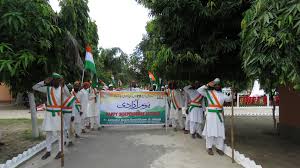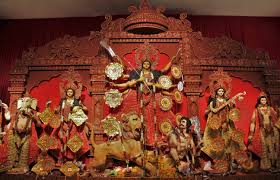FESTIVALS CELEBRATED IN INDIA
India is a land of festivals. The people of India belongs to different religions and cultures though there is unity among them. People of India celebrate many
festivals together. They also celebrate the birthdays of great persons as
festivals. Some festivals are celebrated throughout the country. Some are
celebrated only some particular states.
Festivals bring joy to people. It is a time to wear new
clothes, decorate their homes and exchange gifts.
NATIONAL
FESTIVALS
National festivals are celebrated all over India. The National festivals are Independence Day, Republic Day and Gandhi Jayanti. These festivals are celebrated all over the country.
Independence
Day
Indian people celebrate
15th August, 1947 as their
Independence Day. On this day, India
got freedom from the British rule. The Prime Minister of India hoists the
National Flag at the Red Fort and
addresses the nation. Children attend the flag-hoisting ceremony in their
schools. They, sing the National Anthem.
People sing patriotic songs. They remember the supreme sacrifices made by the
freedom fighters who gave them their lives for India’s freedom.
Independence Day
Republic
Day
India was declared a
Republic
on 26th January, 1950. Since then, this day is celebrated as Republic Day. A grand parade is held at
Rajpath. This parade starts from Rajpath and ends at the Red Fort. The
President of India takes the salute. The armed forces, police, school children
and folk dancers take part in the parade. The states of India display their
achievements through beautiful tableaus. The President gives away bravery
awards to children at Rashtrapati Bhawan. Many government and public buildings
are decorated with lights.
Republic Day
Gandhi
Jayanti
Mahatma Gandhi,
the Father
of the Nation, was born on 2nd October, 1869. Every year this
day is celebrated as Gandhi Jayanti. People from all over the country pay
homage to Bapu. They chant his favourite prayers. The main function is held at
Rajghat. The President, the Prime Minister and others pay respects at the
‘samadhi’ of Mahatma Gandhi.
Gandhi Jayanti
RELIGIOUS
FESTIVALS
People of various religions celebrate different festivals. These are known as religious
festivals. At this time of the year wheat, gram and mustard are ready for harvesting.Basant
Panchami is celebrated at the beginning of the spring season. On this
day, Saraswati, the Goddess of
Learning is worshipped. Boys and girls wear yellow coloured clothes and sing
and dance with joy. Many people fly kites on this day.
Holi,
the
festival of colours, is celebrated mainly in North India. Holi marks the end of
winter. 
Holi celebration
People throw coloured power (gulal) and water on each other. On the eve of Holi, bonfires are lit. This is symbolic of the destruction of the evil Holika.
On Raksha Bandhan, sisters
tie rakhi
on the wrists of their
brothers and pray for their safety.
Raksha Bandhan
Dussehra or Vijaya Dashami is a festival that lasts
for ten days. On this day, Ramlilas are staged. On this day, Lord Rama killed
Ravana, the demon king with ten heads. Dussehra is celebrated as the victory of
good over the evil. Effigies of Ravana, Meghnad and Kumbhakarna are burnt.
The nine days before Dussehra are called
Navratras. |
| Durga Puja |
Diwali, the
festival of lights is celebrated to mark the return of Lord Rama to Ayodhya
after 14 years of exile. People clean and decorate their homes. At night, they
lit candles, diyas and decorative lamps. They worship Lakshmi, the Goddess of Wealth. They burst crackers and other
fireworks. They exchange sweets and gifts. Diwali marks the beginning of
winter.
Diwali
Guruparvs are
celebrated as the birthdays of the Sikh Gurus. Huge processions are taken out through
the cities. The gurudwaras are decorated with lights and prayers are held. Langars are distributed on these days.
Eid-ul-Fitr
marks the end of Ramzan.
People fast all through the month. On this day, people offer prayers at mosques
and Idgahs. When the Eid namaz is
over, people wish Eid Mubarak and
embrace each other. Money and clothes are distributed amongst the poor. Sewain,
a
Guruparv
Christmas is
celebrated on 25th December. It is the birthday of Jesus Christ. Churches are decorated
and prayers are held. People greet Merry
Christmas and exchange gifts. Christmas trees are decorated with stars,
bells and lights. People sing Christmas carols. Santa Claus distributes presents and sweets.
Christmas
Pongal is celebrated in Tamil Nadu. It marks the beginning of the Tamil month,
Thai. It marks the end of rice harvesting. This festival is celebrated for three days. Pongal rice is fed to cows and the Sun God is worshiped.This festival is called Sankranti
in Karnataka and Andhra Prasdesh.
Onam is
celebrated in Kerala.
It is also a harvest festival. It is celebrated in the
honour of King Mahabali. People eat
special food served on banana leaves. The main attraction of this festival is
the snake-boat race. Decorated
elephants are taken out in processions.
Eid
BIRTHDAYS
The Indian people also celebrate the birthdays of some grate
people as festivals. Buddha Purnima is
celebrated as the birthday of Gautam Buddha. Mahavir Jayanti is celebrated as the birthday of Lord Mahavira.
5th Sepetember is celebrated as Teacher’s Day. It is the birthday of
the second President of India, Dr Sarvepalli Radhakrishnan.
14th November is celebrated as Children’s Day. It is the birthday of
the first Prime Minister, Jawaharlal Nehru.
Other festivals like Teej, Shivratri, Ganesh Chaturthi, Chhat and Bihu are celebrated in different parts of India. Fairs are also a part of festival celebrations. In fairs, people have wheels, circus shows, puppet shows and eatables.
India is a land of 'unity in diversity' and it can be seen that though the people of India belong to different caste, religion but they celebrate the festivals together with joy.
Comments
Post a Comment